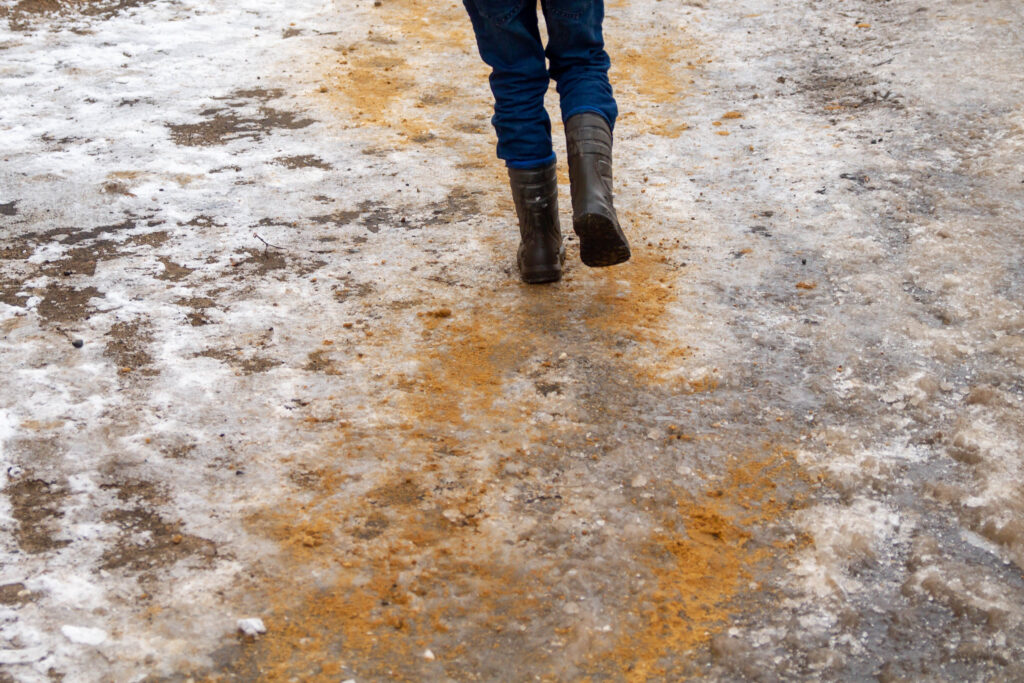

Do you actually need to winterize your concrete?
Yes. Especially if you live in the Midwest.
Concrete is a porous material, so it’s particularly at risk during winter because of the freeze-thaw cycle. When it rains or snows, water can seep into cracks or holes in the concrete and freeze. When water freezes, it expands, which can widen cracks and further extend any existing damage. The freeze-thaw cycle can also lead to accelerated deterioration, or spalling, of the concrete’s surface.
The bottom line is that winterizing your concrete is crucial to prevent costly, long-term damage and maintain its visual appeal. In this post, we’ll cover how to do it properly and share other tips to prevent seasonal damage.

Routine cleaning, like sweeping and deep cleaning, ensures your concrete looks its best for as many years as possible.
Cleaning can be done throughout the year, not necessarily just before winter. You’ll want to sweep away large debris with a soft-bristled broom and either power wash or hand wash your concrete to remove stains or dirt buildup.
If you have a slab, pressure washing (on a low setting) is fine. However, if you have pavers, do not use a pressure washer because you’ll end up removing stabilizing material (e.g., sand) from between the joints. Instead, clean pavers with a mild cleaning solution, such as warm water and dish soap.

While resealing your concrete is key to protecting it, you don’t need to do this every year. Resealing your concrete every three to five years is best practice for decorative concrete, and slabs can often go further between coats. However, there are some tell-tale signs that could indicate your concrete surfaces need immediate resealing, including:
You don’t need a professional to reseal concrete, although it can be helpful if you have pavers. Resealing pavers is a more involved process than sealing slabs, as it requires pressure washing the surface, adding more polymeric sand between the joints, and then sealing the surface. In some cases, multiple coats may be required to ensure even coverage.

While unsightly, cracks can become much worse if they’re not addressed and repaired properly. If water seeps into cracks during the winter and freezes, it will expand and potentially widen the existing cracks, creating more unsightly damage. Small hairline cracks can often be repaired with a crack filler or liquid sealer. However, if they’re larger than 1/2”, we recommend calling in a professional, as these repairs are more complex and may involve widening the crack or cutting out the damaged section.
Regardless of the size of the cracks in your concrete, it is important to get them fixed before winter because they will only get worse.

Caring for your concrete isn’t just about cleaning, sealing, and making any necessary repairs before winter — there are also things you should do during the winter months to prevent damage.
Using standard de-icers, which is what you’ll usually find in home improvement stores, will accelerate scaling, spalling, and cracking, so we recommend using sand. While it won’t immediately melt away snow and ice, it will add traction to prevent slips and falls and absorb heat from the sun, which then encourages melting.
If you are under an HOA and don’t have control over what your landscaping company uses, you can remove any excess rock salt or de-icer with a broom or wash it away with your hose once the snow melts away.

Concrete can become uneven over time from tree roots, soil erosion, concrete damage, and foundational settlement. If not corrected, they can lead to standing water in certain areas and accelerate damage during the winter.
Concrete leveling is the best way to address uneven areas in your concrete. This type of service should only be performed by a professional because it requires understanding where underground utilities are located, using specialty equipment, being exposed to hazardous chemicals like polyurethane foam, and knowing how much pressure to apply, where to apply the pressure, and what materials or mixtures should be used based on soil conditions, load requirements, and general environmental factors.
As Michigan’s leader in concrete services, Detroit Concrete Leveling can help you stay prepared this winter by leveling uneven areas, sealing joints, and replacing damaged concrete steps.
If you need help getting ready for the winter, contact us today to schedule a free inspection and estimate.

Get the quality you deserve from Detroit Concrete Leveling. If you’re ready to start your project, contact us today for a free, no-obligation quote.